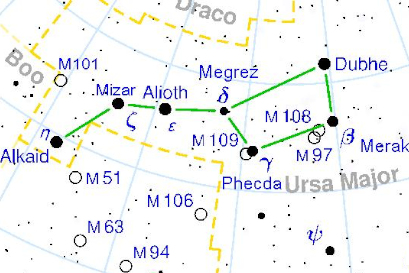- Series:Astronomy, Transcript English
Genesis 1:14
“And God said, Let there be lights in the firmament of the heaven to divide the day from the night; and let them be for signs, and for seasons, and for days, and years:”
 The constellation known as the Great Bear is possibly one of the best known and also wrongly recognized constellation in the sky. The constellation is large, but seven brighter stars make an alternative pattern which is sometimes given its own name, being known in the UK as the Plough and in the US as the Big Dipper. To me, these stars seem to define a saucepan with a long handle.
The constellation known as the Great Bear is possibly one of the best known and also wrongly recognized constellation in the sky. The constellation is large, but seven brighter stars make an alternative pattern which is sometimes given its own name, being known in the UK as the Plough and in the US as the Big Dipper. To me, these stars seem to define a saucepan with a long handle.
This formation is very helpful for finding your way around the sky. If you follow a line upward from the two stars of the “pan” furthest from the handle, the next reasonably bright star you come to will be Polaris. This star is interesting because it is the North Pole Star, seemingly lying vertically above the Earth’s North Pole. So, if you are facing this star, you are facing North, and this can help you find your way at night! Now, if you go back to the Big Dipper and imagine a line from the star at the end of the handle, through Polaris, you will identify a W in the sky, which is actually meant to be the crown of the Queen Cassiopeia. Orion also can be used as a signpost. Orion’s belt is easy to spot, and a line downwards from this will point you to Sirius, the brightest actual star in the Northern Hemisphere.
God has placed these stars to be of use to us for signs and for seasons.
Prayer: We praise You, Lord God, for the good gifts that You have given to every person, such as the gift of the stars of the heavens. What are we, therefore, that You are mindful of us? Amen.
Author: Paul F. Taylor
Ref: Morris, H.M. (2000), The Remarkable Record of Job (Green Forest, AR: Master Books), p. 43. Image: CC BY-SA 3.0 Unported.
Copyright © 2020 Creation Moments, Inc. All Rights Reserved
